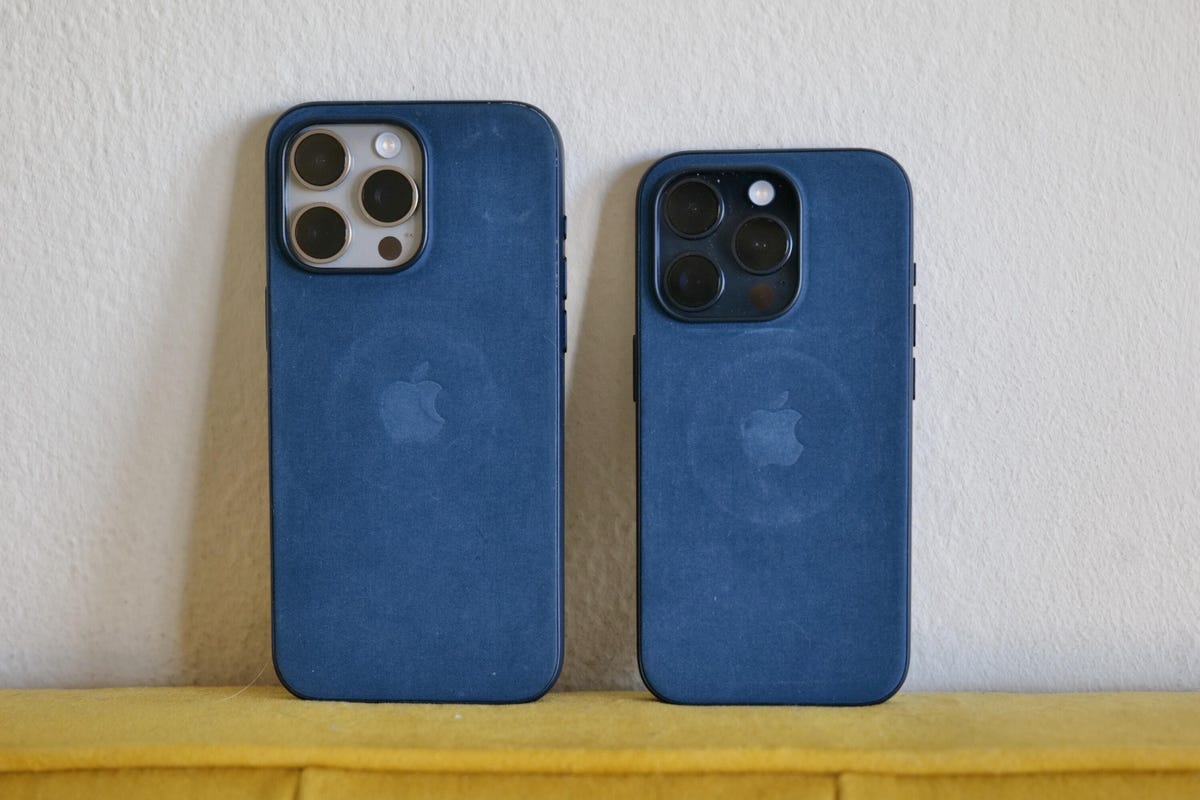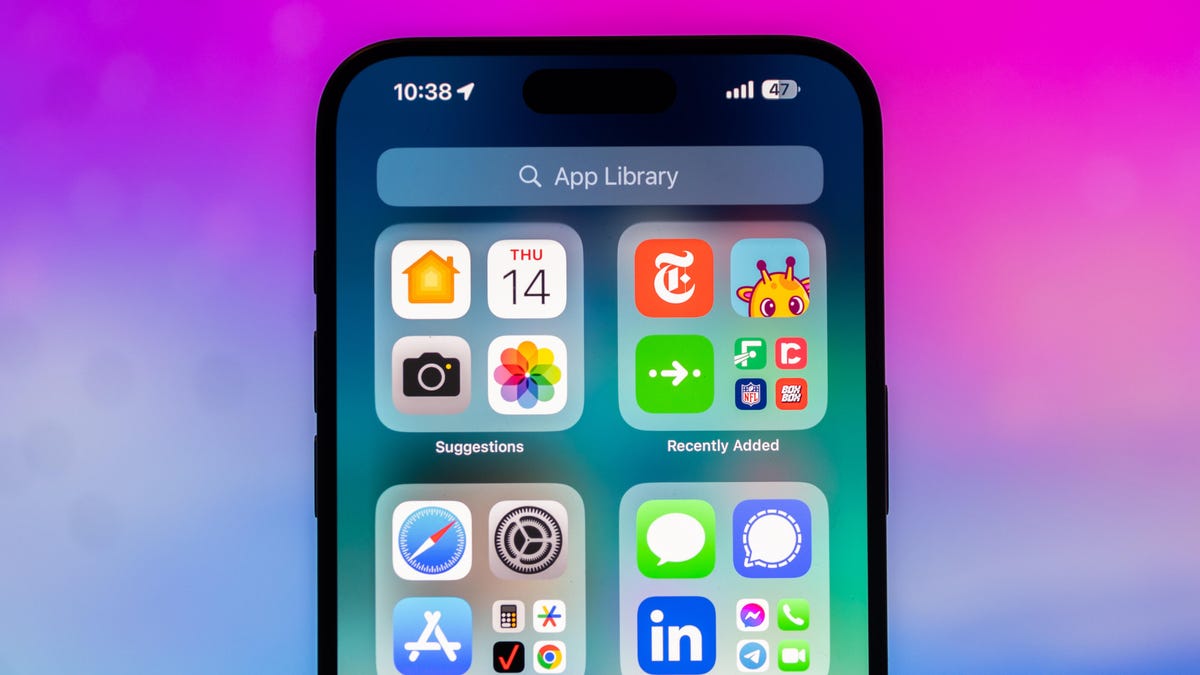Technologies
My iPhone 15 Pro Experience After a Month: These Phones Are Performance Beasts
Commentary: Remarkable CPU and battery test scores show the power of the iPhone 15 Pro and Pro Max. Plus, get the whole scoop on overheating.

The iPhone 15 Pro and Pro Max are defined by their refinements and represent one of the most compelling Apple releases in years. When I initially reviewed both phones, I was impressed with the lighter build, new shortcut button, cameras and the A17 Pro chip. Like the regular iPhone 15, the Pro models have a USB-C charging port instead of Apple’s proprietary Lightning connector, making charging more convenient.
But a lot has happened over the past month. Widespread reports of phones overheating made for a somewhat controversial launch, but Apple has since addressed the issue.
Over the past four weeks, I further tested the iPhone 15 Pro’s cameras, ran CNET’s battery drain test, evaluated performance and conducted charging tests. And I had more time to use the iPhone 15 Pro as my everyday smartphone. Here are my findings.
iPhone 15 Pro-gate(s)
Since the iPhone 15 Pro launched, there have been a few controversies including reports of the iPhone 15 Pro easily bending or experiencing screen burn-in. I have not encountered any of these issues, nor have my CNET colleagues. According to MacRumors, the beta version of iOS 17.1 alleviates the burn-in problem, and the final version, which just came out this week, could do the same. It’s difficult to judge how widespread the burn-in issue is based on these reports alone.
Then there was FineWoven case-gate. Apple announced it would no longer continue to make its own line of leather cases and accessories to help reduce its impact on the environment. As a replacement, Apple launched a new line of FineWoven cases that aren’t made from animal products.

While the cases protected my 15 Pro and Pro Max just fine, the FineWoven cases showed wear and tear after just a week. Dirt and scuffs easily remain; the case on my 15 Pro had scuff marks and indents despite not having used it much the first week. The case’s MagSafe magnet left a circular imprint on the cases for my 15 Pro and Pro Max.
Apple’s support page on taking care of FineWoven cases and accessories includes instructions on how to clean them. I tried this on one of my FineWoven cases, and it got most of the dirt out. But I don’t want a phone case that I have to clean every couple of weeks.
I carry my iPhone 15 Pro Max without a case and use Peak Design’s slim wallet, which is also fabric, but I can touch it without worrying about scuffs. The wallet works with Peak Design’s cases or MagSafe to magnetically attach to the back of my phone. After three weeks of use, the Peak Design slim wallet still looks new, surviving harrowing hours next to keys in my pocket.
Read more: 1 Month Later, the iPhone 15 Is Still an Excellent Upgrade
Perhaps the biggest iPhone 15 scandal involved reports of phones overheating. Apple told CNET that there were four causes that made an iPhone feel warmer than normal, none of which were specifically tied to Pro models, their titanium design or the iPhone 15 series specifically.
When you use a power adapter higher than 20 watts, the phone can feel warm to the touch. This holds true if you’re using a Lightning cable on the iPhone 14 series or a USB-C cable on the iPhone 15 series. I used my MacBook Pro’s 140-watt charger over USB-C to charge the 15 Pro and noticed it was warm to the touch after 30 minutes.
Read more: I Upgraded to an iPhone 15 Pro Max From an 11. Here’s What Happened
According to Apple’s support page, restoring from a backup file or setting up a new phone from scratch can also cause the iPhone to get warmer than normal, as can playing graphic intensive games. When I played Resident Evil Village on the iPhone 15 Pro, it was noticeably warm after 30 minutes.
Certain apps like Instagram and Uber as well as bugs in iOS 17 caused iPhones old and new to overheat. Apple worked with app developers to fix the problem (both Instagram and Uber have updated app versions) and released the iOS 17.0.3 update to solve the issue.

iPhone 15 Pro and Pro Max charging tests
One of the biggest changes to the iPhone 15 series was the inclusion of a USB-C port instead of Lightning. Despite the change, charging speeds are identical to iPhone 14 series models.
I ran several charging tests on the iPhone 15 Pro and Pro Max. I used a 20-watt charger for the first test and noted how the battery percentage increased after 30 minutes. As you can see in the chart below, both the 15 Pro and Pro Max recharged more of their respective batteries than the iPhone 14 Pro and Pro Max.
30-minute charging test (20W adapter)
| Starting percentage | Ending percentage | Percentage added | |
|---|---|---|---|
| iPhone 15 Pro | 4% | 66% | 62% |
| iPhone 15 Pro Max | 7% | 56% | 49% |
| iPhone 14 Pro | 27% | 75% | 48% |
| iPhone 14 Pro Max | 14% | 59% | 45% |
The iPhone caps its max charge speed to 27 watts, so using a power brick that supports a higher wattage won’t make the phone charge any faster. So I ran the same test a couple of more times, using my MacBook Pro’s 140-watt charger. I ran it before and after installing iOS 17.0.3, and the charging speeds were identical. That means the software fix doesn’t throttle charging speeds. Results were nearly the same as those from my 20-watt charging test.
30-minute charging test (140W adapter)
| Starting percentage | Ending percentage | Percentage added | |
|---|---|---|---|
| iPhone 15 Pro before iOS 17.0.3 | 0% | 63% | 63% |
| iPhone 15 Pro after iOS 17.0.3 | 0% | 62% | 62% |
| iPhone 15 Pro Max before iOS 17.0.3 | 18% | 67% | 49% |
| iPhone 15 Pro Max after iOS 17.0.3 | 17% | 67% | 50% |
I ran a 30-minute wireless charging test via MagSafe on both phones, and the results were almost exactly the same. The 15 Pro added 22% over a half hour period, and the 15 Pro Max added 21%.
iPhone 15 Pro and Pro Max battery tests
In my experience, the 15 Pro averages a full day on a single charge, while the 15 Pro Max gets between a day and a half to two days. Battery life can vary depending on how you use your phone, so I also ran two additional CNET battery tests.
The first was an endurance test. Over the course of 45 minutes, I played games, watched YouTube videos, made a FaceTime video call, and scrolled my Instagram and TikTok feeds. As you can see in the results below, both new Pro models did better than the iPhone 14 Pro and Pro Max, as well as Samsung’s Galaxy S23 series. The less battery percentage lost, the better.
45-minute battery endurance test
| Starting percentage | Ending percentage | Percentage lost | |
|---|---|---|---|
| iPhone 15 Pro Max | 100% | 97% | 3% |
| iPhone 15 Pro | 100% | 94% | 6% |
| Galaxy S23 Ultra | 100% | 94% | 6% |
| iPhone 14 Pro Max | 75% | 68% | 7% |
| iPhone 14 Pro | 87% | 79% | 8% |
The second test I ran involves streaming a video over the course of three hours with the battery starting at 100%. I checked the battery level at every hour to see how much the battery percentage dropped. The results show that the 15 Pro and 15 Pro Max last longer than the Galaxy S23 Ultra did in the same test. The less battery percentage lost, the better.
3-hour video streaming test
| After 1 hour | After 2 hours | After 3 hours | |
|---|---|---|---|
| iPhone 15 Pro Max | 97% | 92% | 87% |
| iPhone 15 Pro | 98% | 92% | 86% |
| Galaxy S23 Ultra | 95% | 89% | 82% |

iPhone 15 Pro and Pro Max performance tests
The iPhone 15 Pro and Pro Max have the A17 Pro chip, meaning they can support console video games. I was blown away when I played Resident Evil Village on my iPhone 15 Pro Max. The only sign that the phone was working hard was that the back of the device felt warm after 30 minutes.
I also ran several performance benchmark tests to see just how powerful Apple’s new A17 Pro chip is. I ran the Geekbench 6 CPU test, which measures general performance, and 3D Mark Wild Life Extreme for testing graphics performance.
As you can see in these results below, the A17 Pro chip enabled the iPhone 15 Pro and Pro Max to score higher than any phone we’ve ever tested. They not only outperformed the iPhone 14 Pro Max but every Android phone we’ve tested this year, including the Galaxy S23 Ultra. All of the 15 Pro and Pro Max’s power is kind of overkill now, but should help their longevity as new features and versions of iOS come out.
Geekbench v.6.0 single-core
Geekbench v.6.0 multicore
In terms of graphics, the 15 Pro and Pro Max’s performance is on par with the Samsung Galaxy S23 series, which runs on the Snapdragon 8 Gen 2 for Galaxy chip.
3DMark Wild Life Extreme

Other iPhone 15 Pro and Pro Max standout features
After spending one month with the iPhone 15 Pro and Pro Max, a few features stood out to me. At the top of that list is the 15 Pro Max’s 5x optical zoom. It captures beautiful images with great detail and a wide dynamic range. Check out the photo above that I took of the Manhattan Bridge just after sunrise.
I’m also impressed with the new 24-megapixel resolution option. It basically combines pixel binning image data and resolution image data into a single higher resolution photo that has more detail than photos taken on the 14 Pro or Pro Max.
As I mentioned before, I don’t use a case on the phones and love the way they feel in my hand. Apple found a good balance between the weight and the size of the phone, especially the 15 Pro Max model. The slightly curved edges make the phones enjoyable to hold.
Apple’s iOS 17 software has been a blast to use, especially Check-In and Stickers in iMessage. I get so much joy from turning live photos into animated stickers and peppering them in message threads to the delight and annoyance of my friends.

StandBy mode is also nice and turns the 15 Pro and Pro Max into a mini heads up display for time, photos and other widgets when charging. I use a Belkin BoostCharge Pro dock for StandBy mode at work and a Twelve South HiRise 3 Deluxe dock at home. The StandBy screen looks contemporary, and I like being able to switch between the widgets. I do hope Apple adds more functionality to StandBy mode in iOS 18.
But there are some software bugs in iOS 17. For example, I had Safari freeze and become unresponsive when trying to navigate or reordering tabs. These hang-ups only happened a few times and don’t seem too problematic, but they are annoying.
My CNET colleague Bridget Carey experienced a weird bug in which black borders appeared to the right and underneath photos she took. She said quitting the Camera app and reopening it resolved the issue, even though the pictures she took before the app reset still show up in the Photos app with black borders. There is a MacRumors forum post showing someone else experiencing the same thing.
What’s next for the iPhone 15 Pro and Pro Max? Well, we’re still waiting for Apple to add the ability to record 3D videos (Apple calls them spatial videos), which you’ll be able to watch in 3D on the new Vision Pro headset. The Journal app in iOS 17 still hasn’t launched, though it does appear in the beta version of iOS 17.2. Apple didn’t say exactly when the new app would be released, but I’m keen to try it out. The app uses AI prompts to get you started writing.
After a month with the iPhone 15 Pro and Pro Max, I’m still enamored. And I’m excited to continue testing them for months to come.
Technologies
Stay Informed About Your Flights This Holiday Season With Your iPhone’s Tracker
Your iPhone is hiding a flight tracker. Here’s how it works.

Thanksgiving is only a few short weeks away and if you plan on flying during the holiday season, keeping up-to-date on changes to your flights is crucial. Airports can be hectic during any holiday, but with the government shutdown continuing, flights are liable to change or be cancelled more often.
Luckily, it’s never been easier to get up-to-date information about your flight. For starters, your airline probably has an app, and if not, you can check its website. If you’re in a hurry, you can Google the flight number. Or you can just use your iPhone’s built-in flight tracker that’s sneakily tucked away.
That’s right: Your iPhone has a flight tracker that you may have never known about. It’s there for when it’s needed. Below, we’ll show you have to access it in not one, but two places, so you never have to go hunting for your flight info elsewhere again.
Don’t miss any of our unbiased tech content and lab-based reviews. Add CNET as a preferred Google source on Chrome.
For more on the iPhone, check out everything Apple announced at WWDC 2025.
How to track your flight via iMessage
Before we start, there are a few prerequisites you must meet:
- Make sure iMessage is enabled (it doesn’t work with SMS/MMS).
- You’ll need your flight number somewhere in your text messages, whether you’ve sent that information to someone (even yourself) or it’s been sent to you.
- The flight number must be sent in this format: [Airline] [Flight number], for example, American Airlines 9707.
Launch the native Messages app on your iPhone and open the text message thread that contains your flight information. You’ll know the flight tracker feature works when the text with the flight information appears underlined, which means it’s actionable and you can tap on it.
If your flight is still several months away or it’s already passed, you might see a message that says, «Flight information unavailable.» You might also see another flight that’s not yours because airlines recycle flight numbers.
You can check your flight status from Spotlight Search, too
If getting your flight information from Messages wasn’t easy enough, you can also grab the details right from your iPhone’s home screen by swiping down and adding your flight number into Spotlight Search. Even better, this works with Spotlight Search on your Mac computer, too.
How to access the hidden flight tracker
Although the airline name/flight number format highlighted above is the best way to go, there are other texting options that will lead you to the same result. So let’s say we stick with American Airlines 9707, other options that may bring up the flight tracker include:
- AmericanAirlines9707 (no spaces)
- AmericanAirlines 9707 (only one space)
- AA9707 (airline name is abbreviated and no space)
- AA 9707 (abbreviated and space)
I would suggest you keep the airline name spelled out completely and add a space between the two pieces of information — like in the previous section — because for some airlines, these alternative options may not work.
Real-time flight tracking
Once everything is set, tap on the flight information in your text messages. If the feature works correctly, you should see the following two options appear in a quick-action menu:
- Preview Flight: View the flight’s details. Tap this to view more information about the flight.
- Copy Flight Code: Copy the flight code to your clipboard (in case you want to send your flight details to someone else via text or email).
If you select Preview Flight, at the top of the window, you’ll see the best part of this feature: a real-time flight tracker map. A line will connect the two destinations, and a tiny airplane will move between them, indicating where the flight is at that exact moment.
Underneath the map, you’ll see important flight information:
- Airline name and flight number
- Flight status (arriving on time, delayed, canceled, etc.)
- Terminal and gate numbers (for arrival and departure)
- Arrival and departure time
- Flight duration
- Baggage claim (the number of the baggage carousel)
If you swipe left on the bottom half of the flight tracker, you can switch between flights, but only if there’s a return flight.
For more travel tips, don’t miss our test on whether AI can help you fly more sustainably.
Technologies
How to Get Verizon’s New Internet Plan for Just $25 Per Month
Technologies
This $20K Humanoid Robot Promises to Tidy Your Home. But There Are Strings Attached
The new Neo robot from 1X is designed to do chores. It’ll need help from you — and from folks behind the curtain.

It stands 5 feet, 6 inches tall, weighs about as much as a golden retriever and costs near the price of a brand-new budget car.
This is Neo, the humanoid robot. It’s billed as a personal assistant you can talk to and eventually rely on to take care of everyday tasks, such as loading the dishwasher and folding laundry.
Neo doesn’t work cheap. It’ll cost you $20,000. And even then, you’ll still have to train this new home bot, and possibly need a remote assist as well.
If that sounds enticing, preorders are now open (for a mere $200 down). You’ll be signing up as an early adopter for what Neo’s maker, a California-based company called 1X, is calling a «consumer-ready humanoid.» That’s opposed to other humanoids under development from the likes of Tesla and Figure, which are, for the moment at least, more focused on factory environments.
Neo is a whole order of magnitude different from robot vacuums like those from Roomba, Eufy and Ecovacs, and embodies a long-running sci-fi fantasy of robot maids and butlers doing chores and picking up after us. If this is the future, read on for more of what’s in store.
Don’t miss any of our unbiased tech content and lab-based reviews. Add CNET as a preferred Google source.
What the Neo robot can do around the house
The pitch from 1X is that Neo can do all manner of household chores: fold laundry, run a vacuum, tidy shelves, bring in the groceries. It can open doors, climb stairs and even act as a home entertainment system.
Neo appears to move smoothly, with a soft, almost human-like gait, thanks to 1X’s tendon-driven motor system that gives it gentle motion and impressive strength. The company says it can lift up to 154 pounds and carry 55 pounds, but it is quieter than a refrigerator. It’s covered in soft materials and neutral colors, making it look less intimidating than metallic prototypes from other companies.
The company says Neo has a 4-hour runtime. Its hands are IP68-rated, meaning they’re submersible in water. It can connect via Wi-Fi, Bluetooth and 5G. For conversation, it has a built-in LLM, the same sort of AI technology that powers ChatGPT and Gemini.
The primary way to control the Neo robot will be by speaking to it, just as if it were a person in your home.
Still, Neo’s usefulness today depends heavily on how you define useful. The Wall Street Journal’s Joanna Stern got an up-close look at Neo at 1X’s headquarters and found that, at least for now, it’s largely teleoperated, meaning a human often operates it remotely using a virtual-reality headset and controllers.
«I didn’t see Neo do anything autonomously, although the company did share a video of Neo opening a door on its own,» Stern wrote last week.
1X CEO Bernt Børnich told her that Neo will do most things autonomously in 2026, though he also acknowledged that the quality «may lag at first.»
The company’s FAQ says that for any chore request Neo doesn’t know how to accomplish, «you can schedule a 1X Expert to guide it» to help the robot «learn while getting the job done.»
What you need to know about Neo and privacy
Part of what early adopters are signing up for is to let Neo learn from their environment so that future versions can operate more independently.
That learning process raises privacy and trust questions. The robot uses a mix of visual, audio and contextual intelligence — meaning it can see, hear and remember interactions with users throughout their homes.
«If you buy this product, it is because you’re OK with that social contract,» Børnich told the Journal. «It’s less about Neo instantly doing your chores and more about you helping Neo learn to do them safely and effectively.»
Neo’s reliance on human operation behind the scenes prompted a response from John Carmack, a computer industry luminary known for his work with VR systems and the lead programmer of classic video games including Doom and Quake.
«Companies selling the dream of autonomous household humanoid robots today would be better off embracing reality and selling ‘remote operated household help’,» he wrote in a post on the X social network (formerly Twitter) on Monday.
1X says it’s taking steps to protect your privacy: Neo listens only when it recognizes it’s being addressed, and its cameras will blur out humans. You can restrict Neo from entering or viewing specific areas of your home, and the robot will never be teleoperated without owner approval, the company says.
But inviting an AI-equipped humanoid to observe your home life isn’t a small step.
The first units will ship to customers in the US in 2026. There is a $499 monthly subscription alternative to the $20,000 full-purchase price, though that will be available at an unspecified later date. A broader international rollout is promised for 2027.
Neo’s got a long road ahead of it to live up to the expectations set by Rosie the Robot in The Jetsons way back when. But this is no Hanna-Barbera cartoon. What we’re seeing now is a much more tangible harbinger of change.
-

 Technologies3 года ago
Technologies3 года agoTech Companies Need to Be Held Accountable for Security, Experts Say
-

 Technologies3 года ago
Technologies3 года agoBest Handheld Game Console in 2023
-

 Technologies3 года ago
Technologies3 года agoTighten Up Your VR Game With the Best Head Straps for Quest 2
-

 Technologies4 года ago
Technologies4 года agoVerum, Wickr and Threema: next generation secured messengers
-

 Technologies4 года ago
Technologies4 года agoBlack Friday 2021: The best deals on TVs, headphones, kitchenware, and more
-

 Technologies4 года ago
Technologies4 года agoGoogle to require vaccinations as Silicon Valley rethinks return-to-office policies
-

 Technologies4 года ago
Technologies4 года agoOlivia Harlan Dekker for Verum Messenger
-

 Technologies4 года ago
Technologies4 года agoiPhone 13 event: How to watch Apple’s big announcement tomorrow



